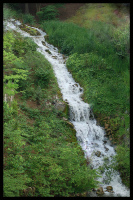
« PREVIOUS ENTRY
Study: Profits are higher at companies run by hot CEOs

This is fascinating: Apparently geologists have spent decades assuming that the shapes of Mid-Atlantic-state rivers were natural — when they’re actually man-made.
Basically, one of the problems with studying rivers in the US is that so many have been warped by commercial and residential development that it’s hard for us to know what the stream ought to look like, naturally. The closest to “natural” that the geologists could identify were rivers of the mid-Atlantic states — which move in ribbon-like channels through silty banks. They assumed, for decades, that this ribbon-like shape was the Platonic solid.
But it turns out that those ribbon-straight rivers were in fact affected by human development, as two scientists — Robert C. Walter and Dorothy J. Merritts — report in Science today. As the New York Times reports:
In a telephone interview, Dr. Merritts described a typical scenario. Settlers build a dam across a valley to power a grist mill, and a pond forms behind the dam, inundating the original valley wetland. Meanwhile, the settlers clear hillsides for farming, sending vast quantities of eroded silt washing into the pond.
Years go by. The valley bottom fills with sediment trapped behind the dam. By 1900 or so the dam is long out of use and eventually fails. Water begins to flow freely through the valley again. But now, instead of reverting to branching channels moving over and through extensive valley wetlands, the stream cuts a sharp path through accumulated sediment. This is the kind of stream that earlier researchers thought was natural.
“This early work was excellent,” Dr. Merritts said, “but it was done unknowingly in breached millponds.”
(Image above by Fhantazm, via his Creative Commons Attribution-NonCommercial-ShareAlike license!)
I'm Clive Thompson, the author of Smarter Than You Think: How Technology is Changing Our Minds for the Better (Penguin Press). You can order the book now at Amazon, Barnes and Noble, Powells, Indiebound, or through your local bookstore! I'm also a contributing writer for the New York Times Magazine and a columnist for Wired magazine. Email is here or ping me via the antiquated form of AOL IM (pomeranian99).

ECHO
Erik Weissengruber
Vespaboy
Terri Senft
Tom Igoe
El Rey Del Art
Morgan Noel
Maura Johnston
Cori Eckert
Heather Gold
Andrew Hearst
Chris Allbritton
Bret Dawson
Michele Tepper
Sharyn November
Gail Jaitin
Barnaby Marshall
Frankly, I'd Rather Not
The Shifted Librarian
Ryan Bigge
Nick Denton
Howard Sherman's Nuggets
Serial Deviant
Ellen McDermott
Jeff Liu
Marc Kelsey
Chris Shieh
Iron Monkey
Diversions
Rob Toole
Donut Rock City
Ross Judson
Idle Words
J-Walk Blog
The Antic Muse
Tribblescape
Little Things
Jeff Heer
Abstract Dynamics
Snark Market
Plastic Bag
Sensory Impact
Incoming Signals
MemeFirst
MemoryCard
Majikthise
Ludonauts
Boing Boing
Slashdot
Atrios
Smart Mobs
Plastic
Ludology.org
The Feature
Gizmodo
game girl
Mindjack
Techdirt Wireless News
Corante Gaming blog
Corante Social Software blog
ECHO
SciTech Daily
Arts and Letters Daily
Textually.org
BlogPulse
Robots.net
Alan Reiter's Wireless Data Weblog
Brad DeLong
Viral Marketing Blog
Gameblogs
Slashdot Games